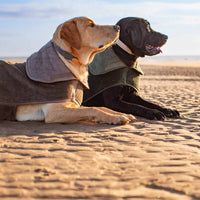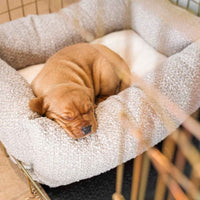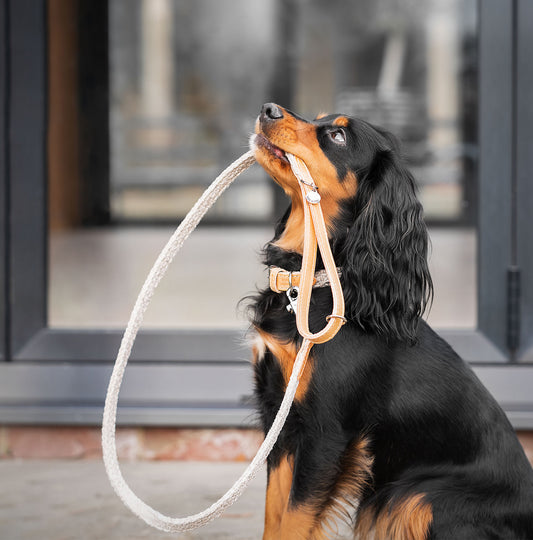As a first-time dog owner, one of the essential items you'll need is a dog lead. It's important to choose the right type of dog lead for your furry friend, as well as understanding the laws and regulations that govern the use of dog leads in public spaces.
In this blog post, we'll cover everything you need to know about dog leads, including the different types of dog leads, UK dog laws and regulations, how to choose a dog lead, and training tips for using a dog lead effectively.
What Are The Best Dog Leashes?
There are several types of dog leads to choose from, each with its own advantages and disadvantages depending on your lifestyle and type of dog. Here are the most common types of dog leads and what we recommend each one for:
Extendable Dog Leads
These leads allow your dog to explore further while still remaining under your control. They have a retractable cord that can extend to several meters and are perfect for walks in open spaces. However, they’re not the best choice for training your dog to walk on the lead without pulling. Extendable leads usually have a metal clip on the bottom which you can attach on to either your dog’s harness or collar. We love the Flexi dog leads, they come in two lengths and have an ergonomically designed handle making them comfortable to hold. They come in 5 colours so there’s sure to be one that you and your pooch will love.
Short Dog Leads
These leads are typically 1-2 meters long and are suitable for walking in busy areas or when training your dog. They provide more control over your dog and can prevent them from pulling or running away. Short dog leads come in a range of materials from rope which is great for stronger dogs, leather which is a good durable option, as well as nylon which are often in stylish patterns and print. Short dog leads will usually have a looped handle to either hold or put round your wrist. Similarly to extendable leads, short dog leads will have either a metal clip or a carabiner on the end so they easily fasten on to your dog’s collar or harness. Our Essentials Walking Collection has a range of short leads in both our Twill and Herdwick fabrics. They are handcrafted in Italy using the finest leather for the handles and either a durable canvas or woven fabric for the strap, finished off with silver hardware - perfect for stylish walkies.
Slip Dog Leads
These leads are made of a loop of material that goes around your dog's neck and tightens when pulled. They’re great for if your dog walks off lead a lot because as the name suggests they’re easy to slip on and off as needed. Because slip leads tighten around the neck when the dog pulls, they may not be the most suitable option for training dogs, especially those that pull on the lead. The tightening of the lead round the dog’s neck can cause them to choke, leading to negative associations with being on the lead and increased anxiety. We recommend these for dogs who already walk well on the lead and if the dog will be off the lead for the majority of their walk. The slip lead we recommend is the Dogs & Horses Rolled Leather Slip Lead, the buttery soft leather is rolled which helps protect your dogs coat from knots. They’re made using cord which is designed for use by yachtsmen so they’re strong and won’t rot if they get wet, this is then wrapped in the softest Italian leather which is hand stitched in their cosy London workshop- these leads have been crafted to last. Available in almost every colour of the rainbow, there’s sure to be one of these gorgeous leads to suit every pup.
Training Line Leads
Training line leads, also known as long lines, are another type of dog lead. These leads are typically longer than standard leads, often 10 meters or more, and can be useful for training purposes, such as recall training or teaching your dog to walk off lead. They provide your dog with more freedom to roam, while still giving you control over their movements. When using a training line lead, it's important to ensure that the line is not too long, as this can lead to your dog getting tangled or running away. Always supervise your dog when using a training line lead, and use a sturdy and durable lead that can withstand the wear and tear of training activities. We love the Ancol Outside Training Line, it comes in two lengths and is perfect for allowing your dog freedom whilst still being in control.
Hands-Free Dog Leads
Hands-free dog leads are designed to allow you to walk your dog while keeping your hands free. These leads are a great choice if you’re planning to run or hike with your dogs. Hands-free leads typically have a waistband or belt that you can fasten around your waist, leaving your hands free to use poles or run without having to hold onto a lead. They can also be useful for people with mobility issues or for those who need to carry bags or other items, whilst being out with their dog. When using a hands-free lead, it's important to ensure that your dog is well-trained and obedient, as they will have more freedom to move around. We love the Ruffwear roamer leash, it can be looped round your waist or can be handheld if needed. The lead has a bungee strap which cushions and stretches as you and your dog speed up or slow down, helping to reduce any impact on both yours and your dog’s joints.
What Are The UK Laws and Regulations For Dog Leads?
In the UK, there are laws and regulations that govern the use of dog leads in public spaces. Section 27 of the Road Traffic Act requires that dogs must be on a lead on designated roads, and if not, the owner could face a fine. What is classed as a designated road is decided by your local authority, so it's always best to check with them.
Similarly, the Countryside Code recommends that dogs should always be under control in public spaces to prevent them from disturbing wildlife or livestock. They recommend keeping your dog on a lead or in sight to ensure they stay away from wildlife, livestock, horses and other people. If you're unsure there are usually signs with that areas rules in, so it's always best to check.

Some areas may also have Public Spaces Protection Orders (PSPOs) that require dogs to be on leads in certain places. It's important to be aware of these laws and regulations to avoid fines and keep your dog and others safe. We recommend checking with your local authority if you’re unsure of the rules in your area.
Choosing A Dog Lead
When choosing a dog lead, there are several factors to consider, including the size and breed of your dog, your dog's behaviour, and your lifestyle. Here are some tips to help you choose the right dog lead:
- Consider the size and breed of your dog: Larger or stronger dogs may require a more robust lead, while smaller dogs may do well with a lighter lead.
- Think about your dog's behaviour: If your dog pulls or is difficult to control, a shorter lead may be more suitable. If your dog is well-behaved and obedient, an extendable lead may be a good option.
- Consider your lifestyle: If you're an active dog owner, a hands-free lead may be more convenient. If you mainly walk your dog in busy areas, a shorter lead may be more suitable.

How To Train A Dog On A Lead
Using a dog lead effectively requires training and patience. Here are out pet experts top tips on training a dog to walk on a lead:
- Start with a short lead and a comfortable collar or harness for your dog, and slowly introduce them to the lead by letting them sniff it and rewarding them with treats.
- Once they’re comfortable with the lead, attach it the collar or harness. You’ll want to start by walking your dog in a quiet, low-distraction environment to help them get used to the lead and build their confidence. This could even be round your garden or in your house before their vaccinations, to help make that first outside walk less daunting.
- If your dog pulls on the lead, stop walking and wait for them to come back to you. Reward them with treats when they do.
- To teach your dog to heel, start by walking them on your left side, holding some treats in your left hand. Hold the lead in your right hand and keep it short but loose.
- Give your dog the "heel" command and start walking. If your dog starts to pull or veer off course, stop walking and bring them back to your left side.
- Reward your dog with treats and praise when they walk calmly by your side, they will begin to associate walking next to you with getting treats and being a positive action. Gradually increase the length of your walks and the level of distraction. As they start walking by your side more consistently you can reduce how frequently you are giving them treats and just reward them with a ‘good boy’ or ‘good girl’ and fuss. Eventually, once the habit has formed, they will consistently walk by your side with no reassurance needed.
- For dogs that have a strong tendency to pull, consider using a front-clip harness like the Ruffwear Front Range harness which allows you to clip the lead on to both the front and back of the harness.

Teaching your dog to heel can be a challenge, but with patience and consistency, it's a skill that can be learned by any dog. Heel training can help prevent your dog from pulling on the lead and make walks more enjoyable for both you and your dog. If your dog has recently started pulling we recommend going back to basics and stopping walking every time they pull and giving them a treat every time they walk by your side, even if you don’t get very far for your first few walks your dog will quickly learn to stop pulling on the lead and walk time will become more enjoyable. If your dog pulls a lot try wearing your dog out in the garden with a game of fetch or tug of war, it may help them to relax on the walk as they have less excess energy.
How To Teach A Dog To Walk Off The Lead
Once your dog is well-trained on the lead, you can start to teach them to walk off lead. You will likely have been practising recall with your puppy at home and this will come in handy when walking your dog off the lead. To teach your dog to walk off lead, start by practicing in a secure, enclosed area. There are now a lot of dedicated enclosed dog fields which you can book that are perfect for practising recall and off lead walking in a safe environment. Start by using a long line lead to give your dog some freedom, but still keep them under control. Use a consistent command, such as "free," to signal to your dog that they can walk off lead and using your ‘heel’ command and recall to get them to walk next to you. As your dog becomes more obedient, you can begin practicing off lead walks in open spaces. It's important to be aware of any potential hazards, such as roads or livestock, and always keep your dog under control.

In conclusion, choosing the right dog lead is essential for both your dog's safety and your own peace of mind. Consider your dog's breed, behaviour, and your lifestyle when choosing a lead, and be aware of UK dog laws and regulations.
Training your dog to walk on a lead requires patience and consistency, but with time, you and your furry friend can enjoy stress-free walks. Teach your dog to walk on a loose lead and use the heel command to prevent pulling. And remember to only walk your dog off lead in safe areas and when they are well-trained and obedient.




























































![[color:black and silver]](http://www.lordsandlabradors.co.uk/cdn/shop/products/dogs-horses-slip-lead-black_5e8b669a-84ce-4026-8dce-e9c502afebda.jpg?v=1666173917&width=533)




































